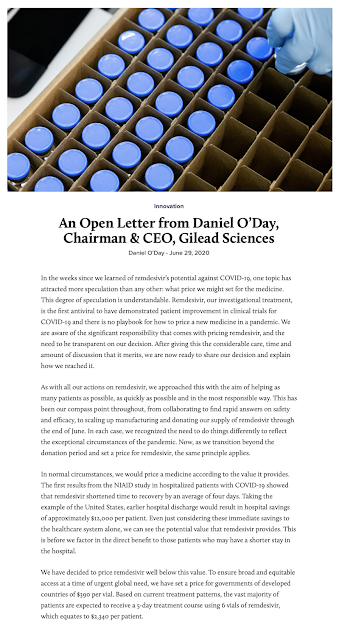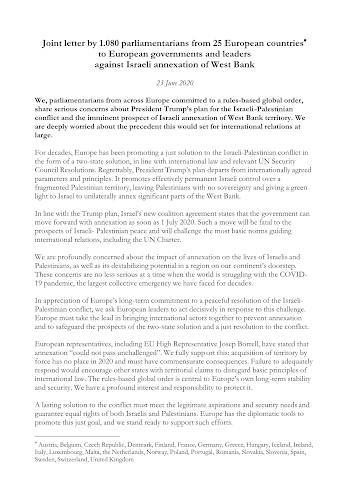Remdesivir is one of the frontline drugs being investigated as a solution to the COVID-19 pandemic. Let's open the posting by looking at what Gilead, the manufacturer of the drug, has to say about remdesivir:
"Remdesivir is an investigational nucleotide analog with broad-spectrum antiviral activity – it is not approved anywhere globally for any use. Remdesivir has demonstrated in vitro and in vivo activity in animal models against the viral pathogens MERS and SARS, which are also coronaviruses and are structurally similar to COVID-19. The limited preclinical data on remdesivir in MERS and SARS indicate that remdesivir may have potential activity against COVID-19.
Remdesivir is an experimental medicine that does not have established safety or efficacy for the treatment of any condition.
Gilead’s response to COVID-19 entails three main areas:
1.) Remdesivir Clinical Trials
2.) Emergency Access to Remdesivir Outside of Clinical Trials
3.) Increasing Manufacturing and Supply for Remdesivir"
Remdesivir is a broad-spectrum antiviral pharmaceutical, developed by Gilead Sciences in 2009, which had been tested previously against RNA viruses including both the SARS and MERS coronavirus. It was originally developed as a drug to combat hepatitis C (which it failed) and was repurposed as a potential treatment for both the Ebola and Marburg viruses.
Remdesivir has undergone Phase 3 trials as a solution to the SARS-CoV-2 virus with the following results:
The full results of the study which was funded by the National Institute of Allergy and Infections Diseases (Anthony Fauci serves as the director of NIAID) and the National Institutes of Health (among others) was published in the New England Journal of Medicine on May 22, 2020. Here is a quote from the article:
"Remdesivir was superior to placebo in shortening the time to recovery in adults hospitalized with Covid-19 and evidence of lower respiratory tract infection."
You might be interested to note that remdesivir was given to 538 patients (mean age 58.9 years) and a placebo was given to 521 patients. Of the remdesivir patients, 334 recovered with a median time of recovery of 11 days and 32 patients died. This compares to 273 recoveries for the placebo with a median time of recovery of 15 days and 54 patients died. Of the patients being treated with remdesivir, 36 had their treatment discontinued because of an adverse event or serious adverse effect (other than death) and 13 had their treatment discontinued because they withdrew consent. The key take-away from this test is that a course of remdesivir reduces the time of recovery from COVID-19 to 11 days from 15 days when the placebo is administered, a four day improvement.
Currently, remdesivir is authorized by the Food and Drug Administration for use in the United States under an Emergency Use Authorization (EUA) for patients with suspected or laboratory-confirmed cases of COVID-19, particularly in patients with severe cases with oxygen saturation levels less than or equal to 94 percent. Here are the first three pages of the FDA Letter of Authorization for the EUA:
Now, let's look at the bottom line. Gilead's CEO, Daniel O'Day posted an Open Letter on Gilead's website. as shown here:
Here is a key quote, keeping in mind that remdesivir was developed nearly a decade ago for a totally unrelated medical condition (i.e. it is being repurposed):
"We have decided to price remdesivir well below this value (the $12,000 savings that hospitals will realize by releasing patients up to 4 days early, thanks to remdesivir). To ensure broad and equitable access at a time of urgent global need, we have set a price for governments of developed countries of $390 per vial. Based on current treatment patterns, the vast majority of patients are expected to receive a 5-day treatment course using 6 vials of remdesivir, which equates to $2,340 per patient.
Part of the intent behind our decision was to remove the need for country by country negotiations on price. We discounted the price to a level that is affordable for developed countries with the lowest purchasing power. This price will be offered to all governments in developed countries around the world where remdesivir is approved or authorized for use. At the current price of $390 per vial, remdesivir is positioned to achieve the aim of providing immediate net savings for healthcare systems.
In the U.S., the same government price of $390 per vial will apply. Because of the way the U.S. system is set up and the discounts that government healthcare programs expect, the price for U.S. private insurance companies, will be $520 per vial. At the level we have priced remdesivir and with government programs in place, along with additional Gilead assistance as needed, we believe all patients will have access." (my bolds)
In case you are interested, here is Daniel O'Day explaining the company's pricing strategy, particularly its two-tier pricing strategy:
Let's close with this information from the 2020 edition of Gilead's Proxy Statement:
It certainly looks like none of Gilead's Named Executive Officers are going to have any problems paying for remdesivir should they require treatment.
Here is the conclusion about remdesivir from a May 22, 2020 paper entitled "The journey of Remdesivir: from Ebola to COIVD-19" by Joe Pardo et al which looked at the history of studying remdesivir as an antiviral drug:
"Infectious disease outbreaks have shaped the course of human history, and with every new outbreak come new challenges. Today, scientists and clinicians around the globe are fighting to halt the COVID-19 pandemic. A chief concern remains: there are no antiviral treatments proven to be effective in fully published, peer-reviewed, randomized placebo-controlled trials. Remdesivir has emerged as a promising candidate based on its in vitro activity against SARS-CoV-2, uncontrolled clinical reports, and limited data from randomized trials. However, expectations should be tempered based on lessons from the past. Remdesivir has potent in vitro activity against Ebola virus, and was highly efficacious in an animal model of Ebola virus disease. Unfortunately, early hopes for a new paradigm in Ebola virus disease management were deflated with the completion of the first randomized trial. Remdesivir holds promise for COVID-19, but the first published randomized trial was underpowered and inconclusive. High-quality data are still lacking at this time. Thus, clinicians across the world now eagerly await complete results from additional randomized trials in COVID-19. Will remdesivir deliver?"
Yes indeed, we do know one thing. Remdesivir will most certainly deliver one thing - profits for Gilead.
Addendum
Since I posted this, the United States Department of Health and Human Services has announced this:
Gilead will receive roughly $1.6 billion for its current and future supply of Remdesivir, between 90 percent and 100 percent of its production for the months of July, August and September 2020. All this for a saving of 4 days of hospitalization per patient. Oddly enough, an off-the-shelf generic drug, dexamethasone which is far less expensive has proven to reduce deaths by 35 percent in ventilated patients and by 20 percent in patients receiving oxygen only. According to Drugs.com, injectable dexamethasone sells for as little as $41.15 for 24 one millilitre doses.

























